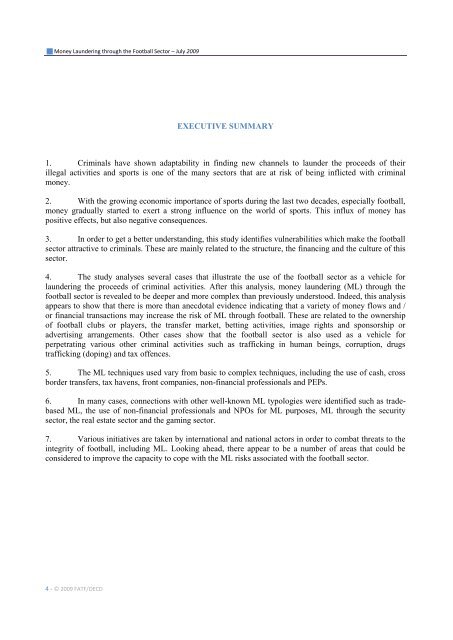Money Laundering through the Football Sector
Money Laundering through the Football Sector
Money Laundering through the Football Sector
Create successful ePaper yourself
Turn your PDF publications into a flip-book with our unique Google optimized e-Paper software.
<strong>Money</strong> <strong>Laundering</strong> <strong>through</strong> <strong>the</strong> <strong>Football</strong> <strong>Sector</strong> – July 2009<br />
4 - © 2009 FATF/OECD<br />
EXECUTIVE SUMMARY<br />
1. Criminals have shown adaptability in finding new channels to launder <strong>the</strong> proceeds of <strong>the</strong>ir<br />
illegal activities and sports is one of <strong>the</strong> many sectors that are at risk of being inflicted with criminal<br />
money.<br />
2. With <strong>the</strong> growing economic importance of sports during <strong>the</strong> last two decades, especially football,<br />
money gradually started to exert a strong influence on <strong>the</strong> world of sports. This influx of money has<br />
positive effects, but also negative consequences.<br />
3. In order to get a better understanding, this study identifies vulnerabilities which make <strong>the</strong> football<br />
sector attractive to criminals. These are mainly related to <strong>the</strong> structure, <strong>the</strong> financing and <strong>the</strong> culture of this<br />
sector.<br />
4. The study analyses several cases that illustrate <strong>the</strong> use of <strong>the</strong> football sector as a vehicle for<br />
laundering <strong>the</strong> proceeds of criminal activities. After this analysis, money laundering (ML) <strong>through</strong> <strong>the</strong><br />
football sector is revealed to be deeper and more complex than previously understood. Indeed, this analysis<br />
appears to show that <strong>the</strong>re is more than anecdotal evidence indicating that a variety of money flows and /<br />
or financial transactions may increase <strong>the</strong> risk of ML <strong>through</strong> football. These are related to <strong>the</strong> ownership<br />
of football clubs or players, <strong>the</strong> transfer market, betting activities, image rights and sponsorship or<br />
advertising arrangements. O<strong>the</strong>r cases show that <strong>the</strong> football sector is also used as a vehicle for<br />
perpetrating various o<strong>the</strong>r criminal activities such as trafficking in human beings, corruption, drugs<br />
trafficking (doping) and tax offences.<br />
5. The ML techniques used vary from basic to complex techniques, including <strong>the</strong> use of cash, cross<br />
border transfers, tax havens, front companies, non-financial professionals and PEPs.<br />
6. In many cases, connections with o<strong>the</strong>r well-known ML typologies were identified such as tradebased<br />
ML, <strong>the</strong> use of non-financial professionals and NPOs for ML purposes, ML <strong>through</strong> <strong>the</strong> security<br />
sector, <strong>the</strong> real estate sector and <strong>the</strong> gaming sector.<br />
7. Various initiatives are taken by international and national actors in order to combat threats to <strong>the</strong><br />
integrity of football, including ML. Looking ahead, <strong>the</strong>re appear to be a number of areas that could be<br />
considered to improve <strong>the</strong> capacity to cope with <strong>the</strong> ML risks associated with <strong>the</strong> football sector.


